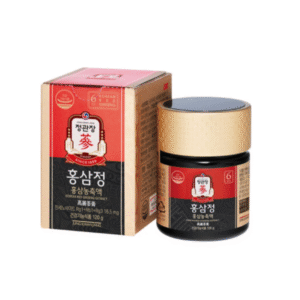Heart disease remains the world’s leading cause of death, yet most of its risk factors — inflammation, high cholesterol, oxidative stress, and poor circulation — can be improved through lifestyle and nutrition.
Among natural remedies, Korean Red Ginseng (Panax ginseng C.A. Meyer) stands out as a scientifically backed adaptogen that supports cardiovascular health, stabilizes blood pressure, improves blood flow, and strengthens heart function.
Let’s explore how this ancient Korean root helps protect and rejuvenate your cardiovascular system, naturally and safely.
🌿 What Makes Korean Red Ginseng Unique
Korean Red Ginseng is not the same as American or Siberian ginseng. Its traditional steaming and drying process enhances the potency of its bioactive ginsenosides — compounds responsible for regulating inflammation, energy metabolism, and vascular function.
These ginsenosides (notably Rg1, Rb1, Rg3, and Re) exhibit a remarkable ability to:
- Enhance endothelial function (improve blood vessel flexibility)
- Reduce oxidative damage in heart tissue
- Support healthy cholesterol levels
- Modulate blood pressure naturally
- Improve circulation and oxygenation
👉 Source: Frontiers in Pharmacology, 2021 – Cardioprotective Effects of Ginseng
🔬 The Science Behind Ginseng’s Cardiovascular Protection
Heart disease is often caused by chronic inflammation and oxidative stress damaging the inner lining of blood vessels (the endothelium). Over time, this leads to plaque buildup, high blood pressure, and restricted blood flow.
Korean Red Ginseng works through multi-target biochemical pathways, protecting the cardiovascular system from within.
1. Improving Endothelial Function and Blood Flow
The endothelium controls vascular relaxation and constriction. Dysfunction here can trigger hypertension and arterial stiffness.
Ginsenoside Rg3 increases the production of nitric oxide (NO) — a key molecule that helps blood vessels relax and widen, improving circulation and reducing blood pressure.
→ Clinical Study: Hypertension Research, 2020 found that participants taking Korean Red Ginseng for 8 weeks experienced significant improvement in endothelial-dependent vasodilation compared to placebo.
✅ Result: Better circulation, oxygen delivery, and reduced heart strain.
2. Reducing Oxidative Stress in the Heart
Free radicals attack heart tissue, accelerating aging and damage to the arterial walls. Korean Red Ginseng boosts the body’s natural antioxidants — superoxide dismutase (SOD) and glutathione peroxidase (GPx) — to protect against oxidative injury.
→ Study: Antioxidants, 2021 – Ginsenosides and Cardiac Protection
→ Outcome: Lower lipid peroxidation and improved cardiac resilience under stress.
This protective effect is particularly valuable for individuals exposed to air pollution, chronic stress, smoking, or poor diet — all major sources of oxidative burden.
3. Balancing Blood Pressure Naturally
Korean Red Ginseng acts as a bi-directional regulator of blood pressure:
- It helps lower high blood pressure by improving vessel dilation and reducing stress hormone activity.
- It can also support low blood pressure cases by improving adrenal function and circulation.
This adaptogenic property makes it unique — rather than forcing blood pressure up or down, it helps the body normalize cardiovascular balance.
→ Study: Journal of Ginseng Research, 2018 — Regular red ginseng intake led to stabilized blood pressure and reduced systolic spikes in hypertensive subjects.
4. Lowering LDL Cholesterol and Supporting Healthy Lipids
Korean Red Ginseng supports lipid metabolism by enhancing the liver’s ability to clear LDL (“bad” cholesterol) and raise HDL (“good” cholesterol).
Ginsenoside Rb1 activates AMPK (AMP-activated protein kinase) — a master metabolic regulator that reduces triglycerides and promotes fat oxidation.
→ Clinical Evidence: In a randomized trial (Nutrition Research, 2019), subjects consuming Korean Red Ginseng for 12 weeks showed:
- ↓ LDL cholesterol by 12%
- ↑ HDL cholesterol by 8%
- ↓ Total triglycerides by 10%
✅ Result: Healthier arteries and reduced plaque formation.
5. Reducing Inflammation in Blood Vessels
Atherosclerosis — the buildup of arterial plaque — is not just a cholesterol issue; it’s an inflammatory disease.
Korean Red Ginseng suppresses inflammatory cytokines (TNF-α, IL-6, and CRP) while increasing anti-inflammatory mediators like IL-10, preventing endothelial damage and arterial stiffness.
→ Reference: Atherosclerosis Journal, 2020 – Anti-inflammatory Effects of Ginsenosides in Endothelial Cells
This mechanism directly reduces arterial inflammation, promoting smoother blood flow and healthier vessels.
❤️ Korean Red Ginseng and Cardiac Energy
Your heart is a high-demand organ, beating over 100,000 times daily. To sustain this, it relies on efficient mitochondrial energy production.
Ginseng’s ginsenosides enhance ATP synthesis and oxygen utilization in cardiac cells, increasing endurance and reducing fatigue — not only physical but cardiovascular fatigue as well.
→ Result: Improved exercise performance, heart rate stability, and reduced post-exertion recovery time.
🧘♀️ Stress, Cortisol, and Heart Function
Stress triggers cortisol and adrenaline surges, increasing heart rate and blood pressure. Chronic stress weakens the cardiovascular system over time.
Korean Red Ginseng, as a potent adaptogen, helps regulate the HPA (hypothalamic–pituitary–adrenal) axis — lowering cortisol, improving parasympathetic activity, and stabilizing heart rhythms.
→ Study: Nutrients, 2021 – Ginseng and Cortisol Modulation
✅ Result: Calm mind, steady heart, balanced circulation.
⚖️ Korean Red Ginseng vs. Common Heart Health Supplements
| Feature | Korean Red Ginseng | Fish Oil | CoQ10 |
|---|---|---|---|
| Main Action | Improves vascular tone, circulation, and metabolism | Reduces triglycerides | Boosts cardiac energy |
| Adaptogenic Benefit | Yes | No | No |
| Blood Pressure Regulation | Bi-directional | Moderate | Minimal |
| Antioxidant Support | Strong (SOD, GPx, NO pathways) | Mild | Moderate |
When combined, Korean Red Ginseng + CoQ10 can offer a synergistic benefit — improving both energy metabolism and vascular protection.
🩺 Dosage and Usage
Recommended dosage:
- 200–400 mg/day standardized extract (3–5% ginsenosides)
- For heart health support: 8–12 weeks minimum
Form: Capsule, tonic, or tea (avoid added sugars).
Safety:
Korean Red Ginseng is well-tolerated in healthy adults. Those taking anticoagulants, antihypertensive medication, or diabetic drugs should consult their doctor first.
→ Safety Review: Phytomedicine, 2019 – Clinical Safety of Panax Ginseng
🌸 Final Thoughts
Korean Red Ginseng is more than a natural tonic — it’s a comprehensive cardiovascular ally that supports the heart, blood vessels, and metabolism from within.
By reducing inflammation, balancing blood pressure, enhancing nitric oxide, and protecting against oxidative stress, it helps preserve cardiovascular function, vitality, and longevity — all without the side effects of synthetic drugs.
For anyone seeking a holistic approach to heart health, Korean Red Ginseng offers both ancient wisdom and modern scientific credibility — a natural pathway to a stronger, calmer, and more resilient heart.
🇰🇷 Premium Korean Ginseng Online Shop







